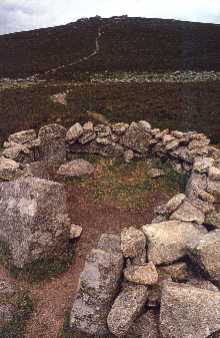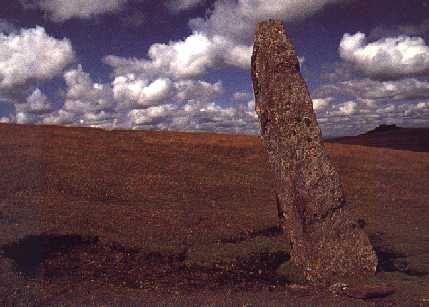|
|
|
Merrivale
|
This is probably the finest area for Bronze Age remains on Dartmoor, and there must have been a considerably sized settlement here. There are two double rows of stones, each with a large standing stone at the uphill end. There are also a couple of kists (burial chambers) and a stone circle with a large standing stone. A significant feature of these rows is the barrow that lies halfway along the longest row. To have a barrow in a ceremonial walkway is very unusual and no doubt marks the grave of a most important person. On all sides of the rows are the remains of stone hut circles, one of which has been excavated and stone arrowheads and tools found. |
The hill on which the Merrivale Stone Rows sit are known locally as the 'plague market.' This name dates from just before the Black Death when bubonic plague was rife and starting to affect the larger towns in England. Provisions grown on the moors were placed here and money left by the inhabitants of Tavistock so that no human contact was exchanged. However the plague still infected the moor dwellers but not so severely.

Grimspound
This is one of several well-preserved huts at Grimspound. This settlement consisted of 8 huts, about 50 people, and had its own spring running through it. The wall surrounding the camp is actually two walls about 10 ft apart, with the gap in the centre being filled with rubble and stones. The walls of the huts were approximately 6 ft high and in the 1800's one hut was almost rebuilt in the original style. The central bearing stone for the roof was replaced as was the hearth and doorway. Within the walls of the pound animals such as sheep, goats and pigs would have been reared for food. |
 |

This is the view of Grimspound from a distance and shows the extent of the settlement

Shovel Down
Shovel Down Stone Row is a double stone row with a burial kist at the end. A single stone row leads to a 10ft high menhir known as the Long Stone. These rows might have represented a path for departing spirits.
